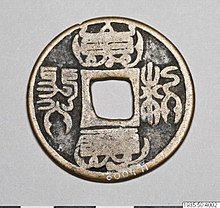Fulu
hideThis article has multiple issues. Please help or discuss these issues on the talk page. (Learn how and when to remove these template messages)
|

| Part of a series on |
| Taoism |
|---|
 |
Fulu (simplified Chinese: 符箓; traditional Chinese: 符籙), is a term for Daoist incantations and magic symbols,[1][2][3] written or painted as talisman or Lingfu (simplified Chinese: 灵符; traditional Chinese: 靈符)[4] [5][6] by Daoist practitioners.
These practitioners are also called Fulu Pai (Chinese: 符籙派) or the Fulu sect, an informal group made up of priests from different schools of Daoism. It is noteworthy that many Daoists do not believe in the use of Fulu, nor are the charms and amulets confined strictly to Daoism as they have been incorporated in to several forms of Chinese Buddhism, and have descendants such as the Ofuda of Japanese Buddhism and Shinto.
Etymology[]
- Fu (Chinese: 符),[7] or Shenfu (Chinese: 神符) are instructions to deities and spirits, symbols for exorcism,[8] and medicinal potion recipes or charms to assist with ailments.
- Lu (Chinese: 籙) is a register of the membership of the priests, as well as the skills they are trained in.
Other names for Fulu in English include Daoist magic writing, magic script characters, magic figures, magic formulas, secret talismanic writing, and talismanic characters.[9]
General design[]
Fu symbols tend to have irregular strokes that resemble Traditional Chinese characters, often elongating existing words while incorporating non-hanzi symbols.[9] Daoist priests are the main interpreters of this eclectic writing-and-symbol system, and the characters can differ from sect to sect.[9] The method of writing down these characters is generally passed down in secret from a Daoist priest to their disciples and treated as a special craft with which to communicate to local deities and spirits.[9]
Some magic script characters appear to have been formed by stacking one Traditional Chinese character atop of another character and compounding them into one.[9] This specific technique of linking or combining different Chinese characters was not used exclusively by the Daoists, however. Fu characters also appear on other types of Chinese charms such as Buddhist coin charms and woodblock print charms.[9]
Healthcare[]

Talismans have for centuries been used in China as a healing method alongside medicinal drugs, meditation, acupuncture, astrology and massage.[10]
Known as zhuyou 祝由 in medical writings, talismans enjoyed official support between the Sui and the late Ming dynasties – before the imperial court recognised acupuncture as a medicinal discipline (ke 科) in the 6th century CE.[11]
Whilst rejected by Traditional Chinese Medicine, zhuyou continues to be widely used amongst Chinese folk healers today. Following the popularisation of psychology in early-twentieth century China, zhuyou began to be interpreted as the Chinese version of Western hypnosis.[12]
Daoist scripture[]
One of the earliest classical scripture referring to Fu was the Huangdi Yinfujing (Chinese: 黃帝陰符經), although it does not contain specific instructions to write any talisman.
The second chapter of each of the three grottoes in the Daozang is a record of the history and feats of the Fulu Sect, where it is described that the origin of Fu script is from the condensation of clouds in the sky.[9]
Fu on Taoist talismanic coins[]

Fu script was also used on Taoist coin talismans (many of which resemble cash coins). Many of these talismans haven't been deciphered yet but a specimen where Fu was used next to what is believed to be their equivalent Chinese characters exists.[9][13][14] On rare occasions Taoist Fu writing has also been found on Buddhist numismatic charms and amulets. Most of these coin talismans that feature Fu writings request Lei Gong to protect its carriers from evil spirits and misfortune.[9]
Fulu characters are usually included at the beginning and the end of the inscription of a Taoist coin charm.[9]
See also[]
- Chinese ritual mastery traditions
- Chinese folk religion
- Chinese spiritual world concepts
- Kai Guang (開光)
- Shigandang (石敢當)
- Ofuda & Omamori
- Thai Buddha amulet
References[]
- ^ "符籙". Ninchanese. Retrieved 11 September 2019.
- ^ "符籙". Ninchanese. Retrieved 11 September 2019.
- ^ "符籙". ApproaChinese. Retrieved 11 September 2019.
- ^ "灵符". Ninchanese. Retrieved 11 September 2019.
- ^ "灵符". Ninchanese. Retrieved 11 September 2019.
- ^ "灵符". ApproaChinese. Retrieved 11 September 2019.
- ^ "Amulettes religieuses (Religious charms)". François Thierry de Crussol (TransAsiart) (in French). 14 September 2015. Retrieved 6 July 2018.
- ^ The Tao of Craft: Fu Talismans and Casting Sigils in the Eastern Esoteric Tradition by Benenell Wen. Publisher: North Atlantic Books. Publication date: September 27, 2016. ISBN 978-1623170660.
- ^ Jump up to: a b c d e f g h i j "Daoist (Taoist) Charms - 道教品壓生錢 - Introduction and History of Daoist Charms". Gary Ashkenazy / גארי אשכנזי (Primaltrek – a journey through Chinese culture). 16 November 2016. Retrieved 10 May 2018.
- ^ Lin, Fu-shih. "「祝由」釋義:以《黃帝內經‧素問》為核心文本的討論". 中央研究院歷史語言研究所集刊. 83.4: 671–738.
- ^ Fan, Ka Wai (2004). 六朝隋唐醫學之傳承與整合. Hong Kong: 香港中文大學出版社. ISBN 9789629961558.
- ^ Bernardi Junqueira, Luis Fernando (2021-06-08). "Revealing Secrets: Talismans, Healthcare and the Market of the Occult in Early Twentieth-century China". Social History of Medicine. doi:10.1093/shm/hkab035. ISSN 0951-631X.
- ^ TAOISTSECRET.COM Taoist Talismans. Retrieved: 10 May 2018.
- ^ Anything Anywhere - CHINA, amulets. Chinese culture is permeated, no, based on poetic allusion, hidden meanings, union of opposites, complex currents of energy and intention. In certain contexts these bases can express in rank superstition (present in all human cultures), and in others can lead to scientific advancement. Retrieved: 10 May 2018.
External links[]
- Amulets
- Talismans
- Taoist practices
- Chinese culture
- Exorcism
- Chinese words and phrases
- Incantation
- Taoism stubs